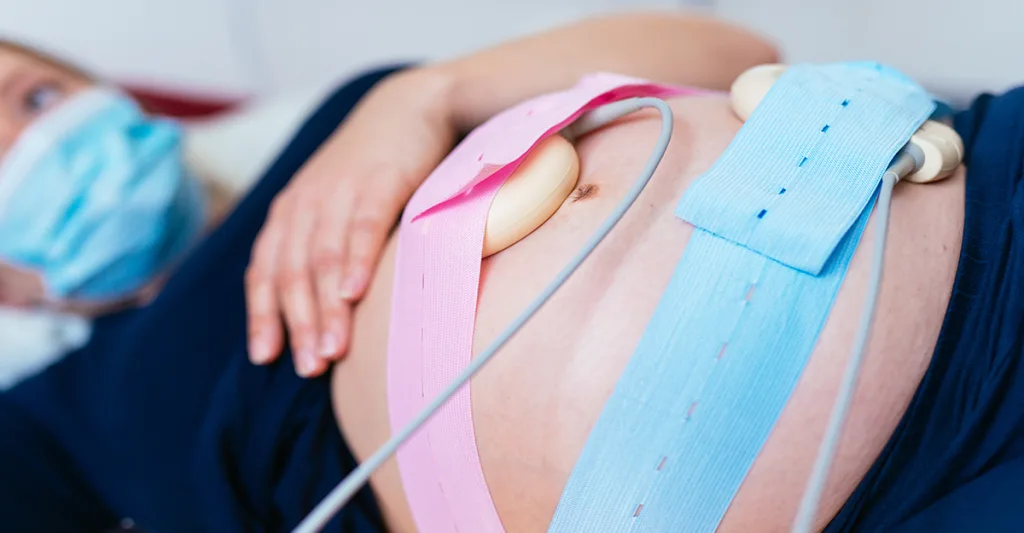Electronic fetal monitoring requires accurate interpretation and clear communication between staff nurses, advanced practice nurses, midwives, and physicians.
The Certified Electronic Fetal Monitoring (C-EFM) designation is one of only a few multidisciplinary certifications, according to Megan Beglin, BSN, RNC-OB, C-EFM, a women's center RN at the George Washington University Hospital in Washington, DC. "A large component of fetal monitoring education is the communication component," Beglin, a speaker for the Nurse.com Electronic Fetal Monitoring Certification Review Course, said. "The certification in electronic fetal monitoring helps to ensure that different providers and different practitioners are speaking the same language." Nurses who plan to spend any part of their careers at the bedside in labor and delivery should consider the C-EFM preparation course and certification, according to Paula Fitt, BSN, BA, RN, C-EFM, IBCLC, a labor and delivery nurse since 1998 and a speaker for the Nurse.com course, which covers fetal heart monitoring technology and interpretation, gestational complications, and more topics. "A lot of facilities now are looking at the RN C-EFM ... as the baseline entry for employment on their units," Fitt said. The course and certification eliminate a lot of potential confusion from what nurses and others might see on a monitoring strip or what they might be hearing when they are using auscultation, according to Fitt. Getting the assessment and ultimate communication right is important. Sentinel events in obstetrics often occur because of poor communication, she said.
An Evolving Specialty
Nurses will find the most current electronic fetal monitoring recommendations, language, and definitions in The 2008 National Institute of Child Health and Human Development Workshop Report on Electronic Fetal Monitoring: Update on Definitions, Interpretation, and Research Guidelines, published in the Journal of Obstetric, Gynecologic and Neonatal Nursing. "[The 2008 report] was the last really big landmark change in how we discuss fetal monitoring," Beglin said. "I would say, however, in the last decade there has been a really big push for more of that multidisciplinary education - more of having providers of all different degrees sitting around the table and receiving the same orientation in assessment training as it pertains to fetal heart monitoring." Fetal monitoring technology has not changed much, but the way it is used in practice has evolved. It used to be that nearly every laboring patient would get electronic fetal monitoring, but the evidence suggests using fetal monitoring as a surveillance device for almost all babies increases the cesarean-section rate, said Fitt. Researchers wrote in a review Electronic Fetal Monitoring and Cesarean Birth: A Scoping Review published in 2016 in the journal Birth that many U.S. hospitals use electronic fetal monitoring continuously during labor for all patients, regardless of risk status. The monitoring can trigger interventions which increase risk of cesarean birth among low-risk women, according to the review. Presently, some nurses might only use this type of monitoring intermittently or for a short time in patients with no risk factors, Fitt said.
Common Settings for Electronic Fetal Monitoring Use
Nurses and other providers most commonly use electronic fetal monitoring during intrapartum care or active labor. Providers also use electronic fetal monitoring in the antepartum setting, which typically involves caring for hospitalized pregnant patients who are not laboring but might have complications or are being evaluated or closely monitored. "Most facilities have an antepartum unit where women will stay for days to months within the hospital," Beglin said. Office settings, including obstetric practices, might also use the monitoring for prenatal visits, according to Beglin.
Knowledge That Leads to Confidence, Satisfaction
EFM certification holds nurses to a nationally recognized standard. And those who achieve the certification are not only proficient in the monitoring but also have a similar level of education and training as professionals in other disciplines who pass the certification exam. "A lot of teaching hospitals will have their residents take [the electronic fetal monitoring certification]," Beglin said. Certification is arguably more important today than in the past because COVID-19 has made communicating during electronic fetal monitoring more challenging.
"We have lost facial cues," Beglin said. "We have lost the capacity to hear sometimes when we are in all the different gear. This is a really great time for somebody to sharpen up on their interpretation and communication skills."
The time it takes to respond to alerts can be longer today because of personal protective equipment protocols, according to Fitt. "We can't go rushing into rooms anymore like we used to," she said. "We have to make sure we are protected first, and that takes some time. Sometimes, it is time that you might not necessarily have." Nurses who do electronic fetal monitoring have not one, but two patients, according to Beglin. "It is an incredible skill to be able to take care of the external laboring woman and ... the hidden, internal baby," Beglin said. "Having confidence in what I can see about the fetal heart tracing enables me to best care for both the invisible and visible patient." Fitt, said that despite doing fetal monitoring for more than 20 years, the practice still fascinates her. "I still learn things about physiology," Fitt said.







